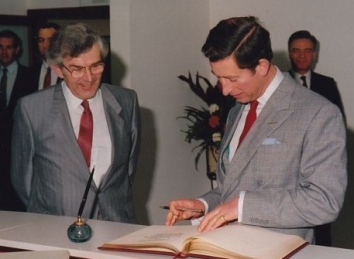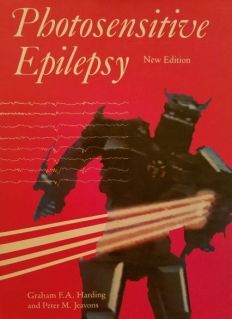Graham Harding, 1937 – 2018
Posted: 11/18/2018 Filed under: Photosensitive Seizure Prevention, TV | Tags: Graham Harding, photosensitive epilepsy, video games Leave a comment
Prof. Harding hosted Prince Charles at the opening of the new Vision Sciences Department building at Aston University in November 1987.
Prof. Graham Harding, a pioneer in photosensitive epilepsy research, has died at age 81. His recent obituary in The Times aptly described him as a world authority on photosensitive epilepsy. Prof. Harding published more than 350 research papers and co-authored a seminal book on photosensitive epilepsy. He was among the first to recognize the risk of seizures from television and video game graphics.
Perhaps most important of all, he crafted image guidelines that reduce the public’s risk of photosensitive seizures from environmental triggers, and he advocated for safer video games. His own research and studies by others showed that specific, measurable qualities of a flashing or patterned image determine its risk of triggering epileptic seizures in individuals with photosensitive epilepsy. Identifying the risk factors and danger thresholds from the flash interval, and the brightness, size, and color contrast of images enabled him to create guidelines for minimizing the chances of seizures.
The need to protect the public
In 1993, flashing images in a commercial on British TV caused seizures in three viewers the first time it aired. In response, the British regulatory agency for television asked Prof. Harding to draft guidelines to limit the public’s exposure to seizure-provoking television images. Four years later, after the Pokémon incident in Japan, the Japanese government asked him to do the same.
Nearly 700 children had arrived at hospitals in Japan for suspected seizures during a Pokémon cartoon broadcast. Prof. Harding later recalled in an interview, ‘The first I knew of it was when my secretary said, ‘The Japanese embassy is on the phone, 400 children have just had seizures,”’ and shortly afterward he was flown to Japan. Doctors found that 560 of the children had probably experienced seizures; 76 percent of them had never had a seizure previously.
Practical solutions
Prof. Harding was clear that seizure warnings on video game packaging and instructions do not provide adequate protection for consumers, citing the 76 percent of Japanese children whose first seizure occurred during the Pokémon cartoon.
While Nintendo, for example, warns that anyone who has had a seizure induced by flashing lights or patterns should consult a doctor before playing a video game, Harding said, that doesn’t protect against a first attack. ″Warnings are good except for people who don’t know they are photosensitive,″ said Harding.
Knight-Ridder Newspapers, December 25, 2002
Ensuring that the guidelines were observed was very time-consuming; he analyzed broadcast video images frame by frame. “Some days I spend four to five hours watching the television,” he said at the time. “It is nice in that it is real applied medical science. Part of my job is stopping people having seizures, so if this is how I do that I don’t really mind.”
With the help of his wife and Cambridge Research Systems, Ltd. he then created the Harding Flash and Pattern Analyzer (FPA) to automate the process, which was nominated for a Royal Television Society technical innovation award in 2001. I have used the FPA many times to check images of video games and music videos.

Prof. Harding co-authored the first monograph on photosensitive epilepsy in 1975.
Other accomplishments
Prof. Harding received his PhD at the University of Birmingham in electroencephalography (EEG) and psychiatry. He spent 40 years at Aston University in Birmingham, where he headed up the Vision Sciences Department and was the first professor of clinical neurophysiology in the UK. When the department opened a new building in 1987, Prof. Harding hosted the Prince of Wales at the opening ceremony. Although he did not have medical credentials, his contributions to medicine were recognized with membership and then fellowship in the Royal College of Physicians.
Prof. Harding was also one of the developers of guidelines to standardize photic stimulation testing, a diagnostic procedure for identifying photosensitivity, and he wrote about the risk of photosensitive seizures precipitated by wind turbines.
It is hard to overstate Prof. Harding’s influence on the study, diagnosis, and prevention of visually induced seizures.
Selected papers
Televised Material and Photosensitive Epilepsy
Persistence of Photosensitivity
Wind Turbines, Flicker, and Photosensitive Epilepsy
